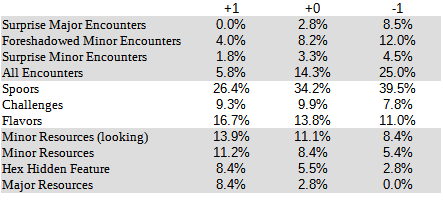Hexclock / Hexcrawl Movement

While playtesting the ruleset I'm working on I ran into some hiccups with overland movement rates. Frequent changes between terrain types caused my simplistic "3 hexes for plains, 2 for forests, etc" rules to not flow as nicely as I'd wish. The multipliers I was using could also combine a bit too extremely, and flat bonuses felt wrong at lower rates where mountains would proportionally benefit far more than plains, for example. Here's the system I came up with as a result - it has worked nicely in my tests thus far. It requires a bit of math though. Nothing hard, but fair warning in case math is especially difficult for you. This is for 3-mile hexes. Cost is how much it costs to enter the hex, from a per-watch budget of 60. Hexes per watch given for ease of reference. A watch is four hours, and they can travel without penalty for two watches a day. 3 watches = Tired, 4 = Exhausted, 5+ = make Grit/Con checks at increasing penalty. For each degree of ease, move one ...




